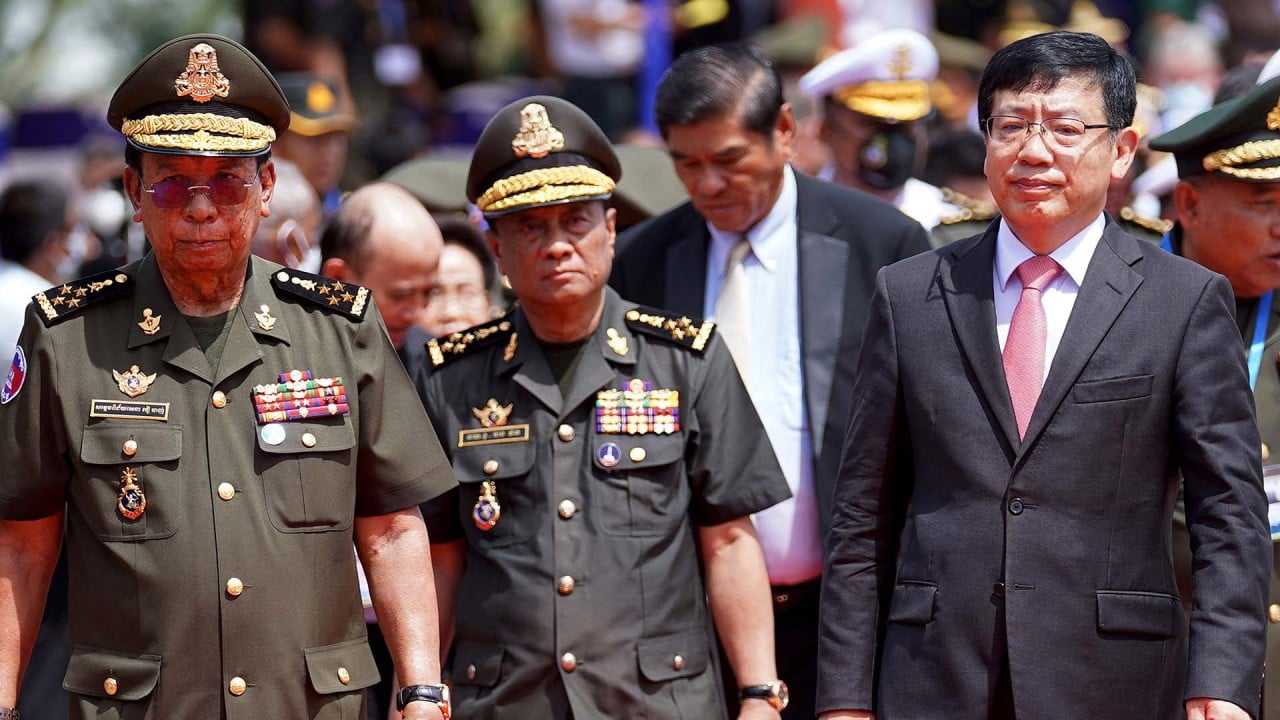
China’s Cambodian navy base project makes US wary, but fears it will host aircraft carrier are unfounded, analysts say
- Satellite images show upgrades at Ream Naval Base in Cambodia nearly finished, and observers say facilities might be used for PLA logistics supply
- Washington wants more transparency regarding port, while Beijing maintains it is aimed at strengthening the Southeast Asian country’s capabilities
On Monday, BlackSky released 10 images showing the progress on the pier, which has been built with Chinese funding and labour, over the past several years. The company has been monitoring the development of the pier since October 2019 and found that construction has proceeded rapidly since August 2021.
An unidentified US official told The Washington Post last June that the Cambodian base could become part of Beijing’s strategy to build a network of military facilities to support its aspirations of becoming a global power.

Chinese foreign ministry spokeswoman Mao Ning said the project, officially announced by the two countries in June of last year, was aimed at strengthening the Cambodian navy’s capability and was in line with the laws of both countries.
Cambodia’s constitution explicitly forbids foreign military bases in its territory.
Cambodian defence ministry spokesman Chhum Socheat confirmed that the pier was nearing completion, but denied that it would be used by the People’s Liberation Army, Agence France-Presse reported on Tuesday.
“It is near completion. We will inaugurate it soon,” he was quoted as saying.
“We already declared that there is no Chinese military base there – we are just modernising our military to reach a capable level in order to protect our territorial integrity.”
But defence experts told the Post that was unlikely.
“Mooring facilities at Ream Naval Base couldn’t fulfil the requirement to house an aircraft carrier with 5,000 crew members. It’s too small and crude,” said Zhou Chenming, a researcher from the Beijing-based Yuan Wang military science and technology think tank.
The Cambodian base was located within the coverage area of the Singapore Area Coordinator at Changi Naval Base, which the US Navy uses for logistics and resupply, he said, adding that “it’s too dangerous for the PLA Navy to berth an aircraft carrier so close to its US counterpart”.
Zhou said if China were to berth an aircraft carrier at the Ream base, it would also have to send its carrier-based fighter jets and air-launched weapons to a nearby airport to ensure security while in a foreign port.
He noted that for the PLA, the safest airport would be in Sanya in southern China’s Hainan province, about 1,000km (621 miles) from the Cambodian base.
“But Sanya is also the PLA’s carrier home port. Why does the PLA need to set up another one in Cambodia?”
Lu Li-shih, a former instructor at the Taiwanese Naval Academy in Kaohsiung, said that sea conditions near Ream Naval Base were not suitable for mooring huge vessels such as an aircraft carrier.
“There are too many shallows around the Ream Naval Base,” Lu said, adding the pier might be used for the 48,000-tonne (52,911-ton) Type 901 Chinese replenishment ship.
Zhou added that PLA vessels could use the base only if the two countries reached a cooperative agreement allowing “port calls” because the Cambodian constitution banned foreign military bases on its soil.
“Construction design and the political status of the Ream Naval Base couldn’t compare to the PLA base in Djibouti, because China couldn’t deploy servicemen or maintenance personnel to Cambodia unless both sides sign an agreement or cooperation on the deployment,” Zhou said.
In military drills with Cambodia, China aims to counter shift towards US
Lu said Beijing could establish transport and logistics agreements with the Cambodian government instead of the more controversial naval base cooperation.
“The PLA Navy has used commercial vessels as transit platforms for logistics supply for a long while, which have now become part of its routine naval training and operations,” Lu said.
Collin Koh, a research fellow at the S. Rajaratnam School of International Studies in Singapore, said the port could provide the PLA a convenient staging area for operations directed westwards into the Indian Ocean, as Cambodia was one of just a few Southeast Asian countries to allow Chinese fleets to access its waters.
“Ream would be much more useful in times of peace, which helps to extend Chinese military power projection further afield. But … Ream is itself constrained by Southeast Asia’s littoral geography,” Koh said.
“It’s prudent not to over-exaggerate the impact it’ll bring. On the whole, the US military enjoys a much more established network of military access in the region and in the adjacent neighbourhood.”
He added that the presence of US allies and close partners such as India also imposed constraints on China’s ability to project naval power in the region.


